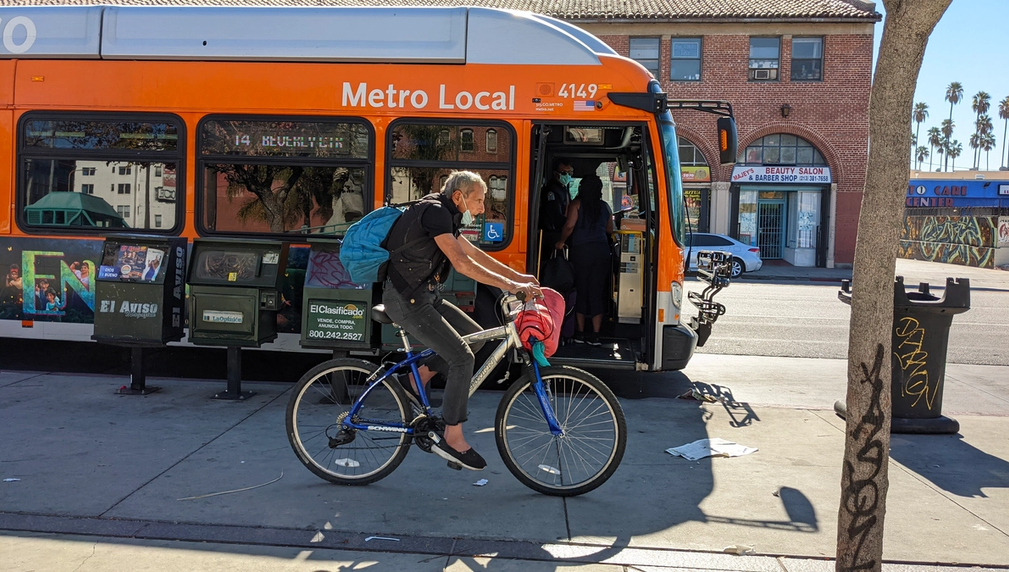Piloting Technology for Safer Streets
Los Angeles streets have seen an increase in collisions and feel unsafe for people walking, biking, and driving, and collisions disproportionately impact communities of color. Redesigning streets is key to creating a safer roadway environment for all but requires significant time, resources, and political capital to implement. In the interim, UML would like to engage community members to identify mobility technology tools that can help make progress towards zero fatalities and severe injuries in Los Angeles and test them via pilot projects.

What is the primary issue area that your application will impact?
Community Safety
In which areas of Los Angeles will you be directly working?
Central LA
South LA
City of Los Angeles
In what stage of innovation is this project, program, or initiative?
Pilot or new project, program, or initiative
What is your understanding of the issue that you are seeking to address?
Traffic fatalities and severe injuries have continued to rise in LA, with 294 deaths and 1,479 injuries in 2021, a 24% and 30% increase from 2020. LADOT’s 20221 Strategic Plan notes that people of color are more likely to rely on transit, walking, and biking and are disproportionately victims in collisions. While only 8% of Angelenos are black, this community represents 20% of pedestrian fatalities. Children are also at risk from a lack of traffic safety as traffic collisions are a leading cause of death for children between ages 5-14. LADOT’s High-Injury Network identifies 6% of city streets that account for 70% of deaths and severe injuries for people walking. An LA Times article noted that these streets are concentrated in Black and Latino neighborhoods, highlighting the disproportionate impacts of collisions experienced by these communities. Working with communities can help identify and test mobility technologies to improve driver behaviors.
Describe the project, program, or initiative this grant will support to address the issue.
USDOT notes that about 5 percent of pedestrians would die when struck by a vehicle traveling 20 mph, and nearly 100 percent would die when struck by vehicles traveling at speeds over 50 mph. Driver speeds are influenced by roadway design and individual driver behaviors. At UML, we want to work with the community to identify mobility technologies that can encourage safer driving behaviors to help reduce collisions resulting in fatalities or severe injuries. To avoid top-down approaches to implementing new technology solutions, UML wants to work with communities to identify roadway safety challenges, discuss solutions, identify potential technologies, and develop a framework for installation that meets the needs of the community. We will accomplish this by: * Partnering with local community groups to engage community members through workshops, surveys, and pop-up engagements to understand local traffic safety concerns. * Identifying community members that can work iteratively on the project with UML as part of a community working group (CWG). * Release a request for information (RFI) for mobility technology companies to propose their solutions for addressing concerns identified with community members. The RFI will be reviewed by the CWG to ensure the communities concerns are effectively represented. * Facilitate pilot projects to understand technology capabilities and work with CWG to introduce community members to the technology and evaluate its effectiveness.
Describe how Los Angeles County will be different if your work is successful.
Short term, our project will allow for collaboration with community members to identify the capabilities of mobility technology intended to improve roadway safety, and will inform how these technologies can best be utilized to support community safety. By identifying and developing pilot projects with the community, we can overcome challenges of top-down implementations, and build a coalition of community members that have identified technology solutions that are best fit for addressing traffic collisions in their community. In the long term, the lessons of our community based process can be replicated in communities throughout the county to reduce collisions with the aid of mobility technology. Pilot performance and all lessons will be documented in a case study to serve as a resource to inform how communities can build on this effort.
What evidence do you have that this project, program, or initiative is or will be successful, and how will you define and measure success?
This program is a new initiative in its early stages. Below, we present the measures of success: * Number of workshops and pop-up events facilitated to engage community members. * Number of community members engaged. * Successful implementation of up to 3 pilot projects. * The number of severe traffic crashes before and during pilot projects. * Safety perception of road users before and after the pilot projects collected via surveys. * The propensity of dangerous driving behaviors such as distracted driving and speeding at the start of the pilot project compared to the end. We anticipate that working with a community working group (CWG) will identify additional metrics that resonate with community members.
Approximately how many people will be impacted by this project, program, or initiative?
Direct Impact: 80
Indirect Impact: 3,000